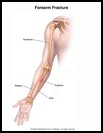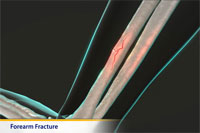
Broken Forearm
What is a broken forearm?
There are two bones in your child's forearm that may be broken:
- the radius (on the thumb side of their arm)
- the ulna (on the little-finger side of their arm).
A crack or break in one of the bones of the forearm is called a fracture. A child's bones are different than adults in some important ways. First, the bones of a child are more flexible. Sometimes the bones crack like green branches from a live tree instead of snapping like a dry stick. Other times the bones just buckle slightly. When this happens, the bone is broken but there isn't a clear fracture line just a slightly raised area on the outside of the bone. The second major difference is that a child's bones are still growing. Bones grow from an area near their ends called the growth plate. Sometimes fractures occur within the growth plate and can be difficult to see on an X-ray. Fractures in this area can effect the growth of the bone and may require special X-rays or other tests.
How does it occur?
A broken forearm usually occurs from:
- a fall onto an outstretched arm or hand
- a direct blow to the arm.
What are the symptoms?
The symptoms are pain, swelling, and tenderness at the site of injury. Your child may not be able to move the arm normally.
How is it diagnosed?
Your child's healthcare provider will examine the forearm and look for tenderness. An X-ray of the arm will show the fracture.
How is it treated?
- If the broken bone is crooked, your child's healthcare provider will straighten it. Your child is given medicine first so the straightening is not too painful. Some fractures that cannot be straightened or that are broken into many pieces may need to have surgery.
- Your child may be given a splint to wear for a few days until the swelling begins to go down. Then the arm will be put in a cast for 4 to 8 weeks.
- Your child's healthcare provider may prescribe anti-inflammatory medicines or other pain medicines.
- Your child should elevate the arm on a pillow or the back of a chair as often as possible for the first 2 to 3 days. This will help control pain and swelling.
- Your child may place ice packs over the cast for 20 to 30 minutes every 3 to 4 hours for the first 2 to 3 days. Most cast material is not made to get wet. If your child needs a cast that can get wet talk to your provider. Your child's provider will determine if the fracture may be safely treated with a waterproof cast.
Don't let your child scratch around or poke things down the cast as this may lead to an infection.
When should I call my healthcare provider?
Call your child's healthcare provider if:
- The pain is getting worse instead of better.
- Your child has a loss of sensation in the hand or fingers.
- You feel that your child's cast is too tight and they have swelling that doesn't get better after the arm is elevated.


